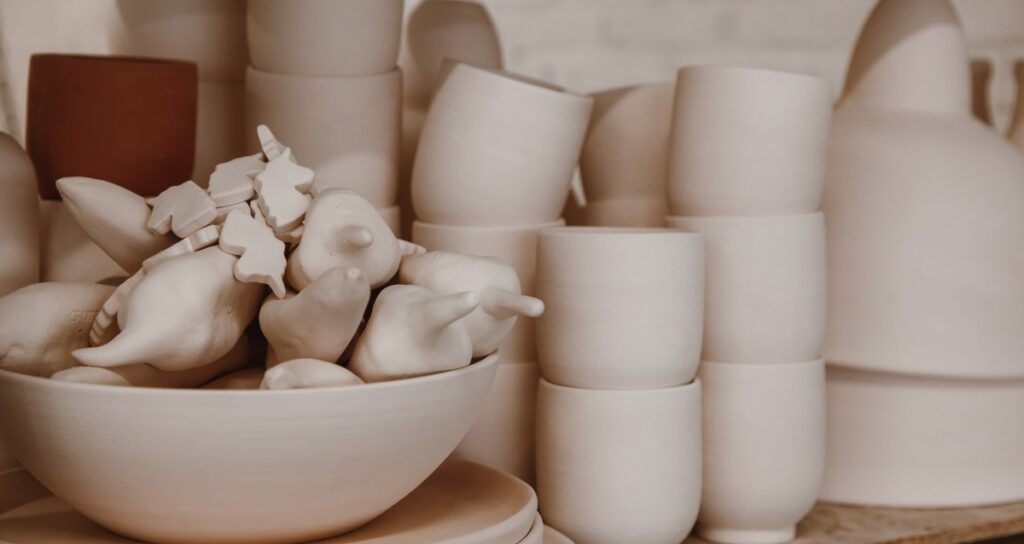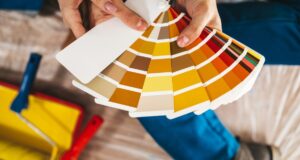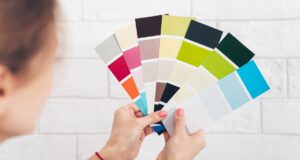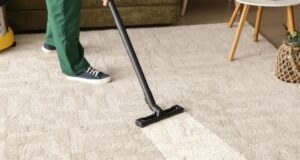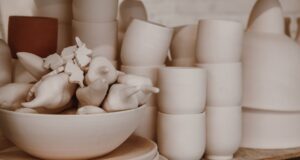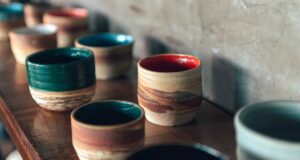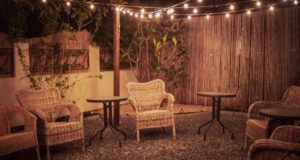Different Kinds of Kiln Shelves
Before I talk about kiln wash, I want to talk about kiln shelves.
The kiln shelves that I’ll be referring to in this article are high alumina kiln shelves. Alumina is highly refractory, meaning it melts at a super high temperature (cone 42) which makes it a good material for making kiln shelves.
High alumina kiln shelves are the beige coloured shelves that are sold with most electric kilns nowadays. They are the cheapest kiln shelves you can buy and they work well but are prone to warping after many high-temperature firings.
There are other kiln shelves out there that are lighter, don’t warp, are more expensive and don’t require kiln wash. Nitride-bonded-silicon-carbide shelves, for example, don’t require kiln wash because glaze won’t stick to them (magic!). If you have this kind of kiln shelf, you don’t necessarily need to worry about kiln wash.
But if you have high alumina kiln shelves like I do, using kiln wash is highly recommended.

High alumina kiln shelf without kiln wash
Kiln Wash Saves Our Kiln Shelves
Kiln wash is a material that you can paint onto your kiln shelves. It looks very similar to a glaze when being applied. It acts as a barrier to prevent unexpected glaze runs or drips from ruining your shelves.
Kiln shelves are made of a hard material that is similar to fired clay. If you don’t use kiln wash, any glaze that comes into contact with your kiln shelf gets absorbed and becomes permanently fused to it.


Glaze drips on unprotected kiln shelves
The only way to get the glaze off a bare shelf is to grind down the part of the shelf that the glaze has stuck to. This is a process that takes time, elbow grease and usually leaves your shelves gouged, bumpy and uneven.
We don’t want bumpy, uneven shelves because this can cause our pots to warp during the glaze firing. We want our shelves to be nice and flat.
When we do use kiln wash and our glaze runs, the kiln wash prevents the glaze from coming into contact with the shelf. Our pots may be ruined but we’ve saved our shelves! This is a win because kiln shelves aren’t cheap.
The reason kiln wash is so effective is because it’s very high in alumina (like our shelves). Remember, alumina is a refractory material that won’t melt at our firing temperatures. So the kiln wash won’t fuse to our shelves.
Since kiln wash can’t fuse to the shelf like a glaze can, the layer of kiln wash can be removed from the shelf. Think of it like a drop cloth when painting a room. Any paint drips are absorbed by the drop cloth and then the drop cloth can be removed, leaving a drip-free floor underneath.
The drop cloth protects the floor, the kiln wash protects the shelves.
So a glaze that runs or spits (or was not wiped from the bottom!) will stick to the kiln wash, not the kiln shelf. Then the kiln wash can be removed from the shelf, saving the shelf from potential permanent scarring.
Kiln Wash Saves Our Pots
Kiln wash can also save our runny glazed pots from cracking when removing them from the shelf. If a piece is fused to a bare shelf by glaze, something will have to break in order to remove it (usually the pot is sacrificed, saving the shelf).
But since the kiln wash allows the pot and glaze drips to be released intact (if the drip is small enough) it may be possible to grind the drip off the bottom of the pot and still have a fully functioning piece of pottery.
Porcelain Plucking
The other thing kiln wash prevents is our clay sticking to our kiln shelves. Some porcelains, due to their high silica content, become so fluxed (melted) during the firing that they have the potential to stick to an unprotected kiln shelf.
This can lead to “plucking” where small bits or splinters of clay stay fused to the shelf, breaking free from the piece itself. It’s a disappointing way to ruin a beautiful piece of pottery.
A good kiln wash should prevent plucking, although a potter recently informed me that she is experiencing porcelain plucking with her commercial kiln wash.
Since we don’t know what a commercial kiln wash is made of, I can’t say exactly why this is happening. It’s possible that the kiln wash is high in silica like porcelain, and they’re both fluxing and fusing together.
What I do know is that we solved our plucking issue with the kiln wash recipe I share down below.
We were experiencing plucking with porcelain at the studio where I work. We use small discs of clay as “cookies” so any glaze drips will land on the cookie, which we can throw away. This prevents a lot of kiln shelf maintenance.
The cookies were originally made of bare clay with no kiln wash. Once I noticed the plucking, I decided to apply kiln wash to the cookies as well as the kiln shelves. Since we started kiln washing the cookies, we haven’t experienced any more plucking.
How to Make a Good Kiln Wash
You can often buy kiln wash in powder form from your ceramic supplier. You just add water and it’s good to go.
You can also make your own kiln wash from ingredients that you likely have in your glaze lab. It’s cheaper to make your own and you can also tailor the kiln wash recipe to suit your needs.
A good kiln wash is not too flaky or powdery but comes free from the kiln shelf with little effort. It requires minimal maintenance when your glazes are behaving.
I found that the commercial kiln wash I tried was way too flaky. I don’t know what kind it was, I inherited it with a bunch of other glaze materials.
A flaky kiln wash is messy, has to be re-applied often, and has the potential to land on your glaze during the firing.
Cracking and flaking is caused by the kiln wash materials shrinking. This can be prevented by designing your kiln wash for minimal shrinkage, which I have done in the recipe I share below.
The other thing you don’t want is a kiln wash that is too hard to remove from your kiln shelves. This can happen if your kiln wash contains flux, or if you’re firing in a flux-filled atmosphere (wood, salt, soda firings).
The best kiln wash stays stuck until you try to remove it, and then it scrapes off easily.
What Kiln Wash is Made Of
Most kiln wash recipes out there contain some combination of three ingredients: Alumina, EPK and/or Silica.
Some use just one or two of the three and some use various combinations of all three. Some recipes contain other materials but these are the 3 I have used.
Let’s look at these 3 ingredients and what properties they each bring to the kiln wash.
Alumina: highly refractory, expensive ($7.34/kg), powdery, doesn’t melt, doesn’t shrink
EPK: highly refractory, cheap ($2.23/kg), bonds other particles together, doesn’t melt, high shrinkage
Silica: highly refractory, very cheap ($1.96/kg), can melt if it comes into contact with fluxes, doesn’t shrink
(costs are from my Canadian supplier in 2019)
Sue’s Kiln Wash Recipe
I’ve created a kiln wash recipe that takes all of these properties into account and uses each of them to their greatest advantage.
I measure each material by volume, or by the scoop. I don’t bother weighing since it doesn’t need to be exact.
2 scoops Alumina Hydrate
1 scoop EPK
1 scoop Calcined EPK
1 scoop Silica
Flocculate with Epsom Salts solution
Here’s a link to my kiln wash recipe on glazy.org https://glazy.org/recipes/49756
Now I’ll walk you through how I came up with my kiln wash recipe by describing each material in more detail.
Start With Alumina
We could make kiln wash out of pure Alumina. We can sprinkle alumina hydrate onto our kiln shelves, or we can mix it with water and paint it on. Alumina is all that’s required as a barrier between our runny glazes and our kiln shelves.
Using pure alumina means you have a powder that does not bond with the kiln shelf. It remains a powder during the firing and can be poured back into a container and reused.
The benefit of using pure alumina is that your kiln shelves remain bare and kiln wash free so they can be flipped over, firing to firing, preventing warpage.
Using alumina powder also gives your pots the freedom to move during the firing, without friction. All pottery shrinks during the glaze firing and if there is too much friction between the pot and the kiln shelf while the pot is shrinking, the pot may crack.
Using a powder that can move eliminates the friction, kind of like ball bearings. This is especially helpful when firing extra wide pieces that have a large point of contact with the kiln shelf.
The issue with pure alumina is that you have to be careful that none of the alumina powder falls onto any of your glazed pieces. If so, it will become a permanently embedded blemish in your fired glaze.
The fact that I work at a busy pottery studio where kilns are being loaded and unloaded daily by several different people means using a loose powder in our kilns could be messy and disastrous. It’s important that our kiln wash sticks to the shelves and stays there.
This is where the EPK comes in.
Add Some EPK
By adding EPK (or any kaolin) to the alumina, we still have a highly refractory kiln wash, but the kaolin helps to bond the alumina particles to each other, and to the kiln shelf.
Note that bonding is not the same as melting and fusing. The EPK helps the particles stick together like clay sticks together, but they don’t stick permanently to the kiln shelf as a glaze would.
The EPK also helps to keep the kiln wash in suspension, so it mixes well and doesn’t hard-pan in the bucket.
I often see kiln wash recipes that are 50% alumina and 50% EPK. But there’s a problem with this recipe.
One drawback of using kaolin is that it shrinks. Kaolin is clay and we all know that clay shrinks when it dries and when it’s fired. This is true for kaolin in a glaze recipe and kaolin in a kiln wash recipe.
Too much kaolin causes the kiln wash to shrink too much, crack and flake off. If kiln wash flakes off during the firing, it can land in your pots and cause blemishes in your glazes.
A glaze recipe with over 25% EPK can have problems with shrinking, cracking and crawling. Same with kiln wash. So this 50% alumina 50% EPK recipe has way too much EPK, causing way too much shrinkage.
The solution to this is to substitute some of the EPK with Calcined EPK. I do this with glazes, and I do it with kiln wash.
Substitute Half the EPK with Calcined EPK
Calcined EPK is EPK that has been fired high enough to remove the chemically bound water molecules, essentially pre-shrinking it. I wrote a whole article on how and why to calcine EPK here.
So I substitute half the EPK with Calcined EPK. This greatly reduces the shrinkage but provides enough clay for the kiln wash to bond with itself and the kiln shelves.
Now I have a 4 part recipe:
50% Alumina, 25% EPK and 25% Calcined EPK.
This could also be written as:
2 parts Alumina, 1 part EPK and 1 part Calcined EPK
because I don’t weigh the materials, I just go by the scoop.
Add Some Silica as a Cheap, Non-Shrinking Filler
The recipe I had at this point should be just fine, but I took it a step further.
I had seen kiln wash recipes that call for silica so I tried adding 1 part silica. By adding 1 part silica, I now had a 5 part recipe.
40% Alumina, 20% EPK, 20% Calcined EPK and 20% Silica
or
2 parts Alumina, 1 part EPK, 1 part Calcined EPK, and 1 part Silica.
Adding 1 part silica only reduced each of the other materials by a small amount. Since silica is very inexpensive, I see it as a cheap, non-shrinking filler.
It reduced my EPK from 25% to 20%, which would reduce the overall shrinkage of the kiln wash.
I also read that the silica may act as a hardener, causing the kiln wash to hold up to more wear and tear before crumbling and needing to be replaced. I can’t confirm or deny this claim, but I do know that our kiln wash lasts many, many firings before we have to scrape it off and start fresh.
I’ve been using this kiln wash recipe for 5 years in a high volume studio that fires 5-6 kiln loads/week and it has been amazing! Eventually, it does start to crack and need replacing but we can go several months before any maintenance is required if there are no glaze disasters.
How to Apply Kiln Wash
Kiln wash can be applied by paintbrush, roller or by spraying. I’ve only tried the brushing method. A friend of mine uses a roller and swears it’s life-changing, but I have yet to go out and buy a roller to try it.
Make sure your kiln wash is well mixed before applying. You want it to be homogenized. I stir with my brush each time I dip back into the kiln wash.
When brushing kiln wash, I always use a large wet sponge to dampen the kiln shelf first. Pre-wetting the kiln shelf prevents the water in the kiln wash from being absorbed into the shelf too quickly. We want the kiln wash to stay wet until we have an even coat.
I use a wide, soft-bristled brush that will hold as much kiln wash at a time as possible. Dip the brush into the kiln wash and without rubbing the bristles on the edge of the bucket to remove excess, start painting the shelf.
As soon as the brush is dry, go back for more. Apply the kiln wash very liberally with long strokes. The key is to get a nice even coat. Using many small brushstrokes can make for an uneven layer.
Once the shelf is covered, I allow it to dry to the touch and then add another layer.
When finished, wipe any drips off the edges of your shelves. If you leave them, they could flake off and land in your glazed pots during the firing.
And make sure you don’t get any kiln wash on the bottoms of your shelves either. Tops only!
Always make sure your kiln wash is completely dry before firing. It will change from a darker colour to light when it’s dry. If the kiln wash is still damp and you put it in the kiln, you have more chance of it flaking and not adhering properly to the shelf.
They may take a couple of days to dry. To speed up drying, use a fan or put near a hot kiln.
If possible, put your freshly kiln washed shelves through a bisque firing before a glaze firing. Bisque firings are generally slower so any leftover moisture has time to escape. This isn’t always possible but if I have the option, that’s what I do.
After the first firing, check your shelves. If you can see the shelf through the kiln wash, add another layer. You want the kiln wash to be thick enough to prevent glaze from seeping through.
Kiln Shelf Maintenance
There’s a lot I could say about kiln shelf maintenance. In the future, I’ll write another detailed article all about it.
But I will leave you with one kiln shelf maintenance tip.
Over time, your kiln wash will start to flake and chip off. You may have craters of un-kiln-washed areas. Especially if your glazes have been running.
